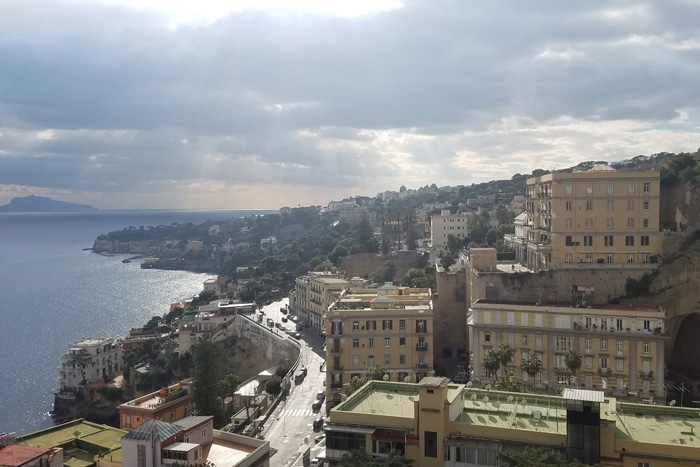One Italy, Three Perspectives

A view of the Vomero area of Naples from Corso Vittorio Emanuele, a long, famous road in the city. One of the main characters of Elena Ferrante’s Neapolitan Quartet novels briefly lives there. Photo by Thera Dal Prà Iversen '17.
Students discover abundant research opportunities in Italy
People go to Italy for a million different reasons (the culture, food and history come to mind). And for three Dickinson seniors, the reasons they visited the Mediterranean country are as varied as any you’d find.
At the spring 2017 International Research Symposium in the Stern Great Room, Natalie McNeill, Thera Dal Prà Iversen and Delphine Dall’Agata wrapped up their theses with presentations detailing research trips to locations across Italy. There, they explored, respectively, the watershed of Parco del Mincio, the physical and cultural implications of author Elena Ferrante's Naples and urban agriculture in Bologna.
Big(ger) picture
“My experience as an employee at ALLARM, my research about volunteers and learning about issues related to the Chesapeake Bay watershed made me want to tackle a similar project in Italian to fulfill my Italian studies major,” says McNeill, who, like Dall’Agata and Dal Prà Iversen, was a recipient of a William G. and Elke F. Durden International Initiative Fund award.
Through her research at Parco del Mincio in Mantua, McNeill (who double majors in environmental science) sought to understand what motivates volunteers to become involved with the park. On the heels of the research she conducted for her honors thesis in environmental science, she also wanted to understand what volunteers’ environmental concerns are and what issues are present within the watershed.
“I found that many people focused on local issues and did not discuss how those local issues fit into the puzzle piece of the surrounding area,” McNeill says. “This was a valuable experience because I realized that there are many ways to address environmental problems, but that recognizing the interconnected nature of our world is important because it may help make management efforts more successful.”
Here and there
For Dall’Agata (Italian studies, Spanish), it was a similar thread of interconnectedness that drove her to Bologna.
“I studied abroad there in the spring and was familiar with the city, and I had a growing interest in sustainability through my education here at Dickinson,” she says, noting that she wanted to focus on a sustainable initiative in Italy for her honors thesis. “I'm from Chicago, which has a large urban agriculture movement, so I was familiar with that and was curious if it was continued in Bologna.”
What she found when she looked into it was a vibrant community involved in urban agriculture at places such as a city-owned garden, a preschool, an urban farm and an African garden in a refugee welcome center. She also found that the long history of urban gardening in Bologna has led to very modern goals: reestablishing sustainable local food, reclaiming abandoned urban zones, educating future generations, creating collaborative integrated communities and establishing a greener Bologna.
What’s between us
For Dal Prà Iversen (English, Italian studies), Naples provided an extension of her Italian honors thesis, a study of Elena Ferrante’s Neapolitan Quartet, consisting of the books My Brilliant Friend, The Story of a New Name, Those Who Leave and Those Who Stay and The Story of the Lost Child.
“I chose going to Naples to conduct hands-on research because the city is vital to the story in the Neapolitan Quartet—Ferrante refers to several specific places in Naples in which the story unfolds, thus creating a visual map of Naples in her writing,” Dal Prà Iversen says, calling her research “a mix of a socio-semiotic study of Naples, mixed with a personal memoir of my own experience of being a woman in Naples and my own identity.”
Her experience in the city involved a lot of exploration of the Quartet’s locales to see how various neighborhoods shaped the series’ characters. It was there that a theme parsed in her thesis—that of “dissolving margins”—also came alive on a different level.
“In essence, I used my own body as a referent—I tried to understand what kind of sensations the Neapolitan landscape gave me, which made the research process very personal,” she says, noting that in certain neighborhoods she felt her marginality, as a visitor, but in others, no one noticed her at all. “It was interesting to ‘observe myself’ in a foreign city, to understand how I interact with a landscape that I’m unfamiliar with, and how other people observe me as either foreign or native depending purely on the environment that I’m in. I started to realize that not everywhere I go am I an outsider.”
These three projects were completed as the students' honors theses with the support of faculty supervisors and readers. For McNeill's and Dall’Agata's projects, the supervisor was Nicoletta Marini-Maio, and the reader was Luca Trazzi. For Dal Prà Iversen's project, the supervisor was Marini-Maio, and the readers were Ellen Nerenberg of Wesleyan University and Nicola Lucchi. More information about the honors thesis process is available on the department's curriculum page.
Learn more
- Department of Italian & Italian Studies
- Dickinson's Bologna Center
- Sustainable Dickinson
- Department of Environmental Studies & Environmental Science
- Department of Spanish & Portuguese
- Department of English
- Latest News
Published May 10, 2017